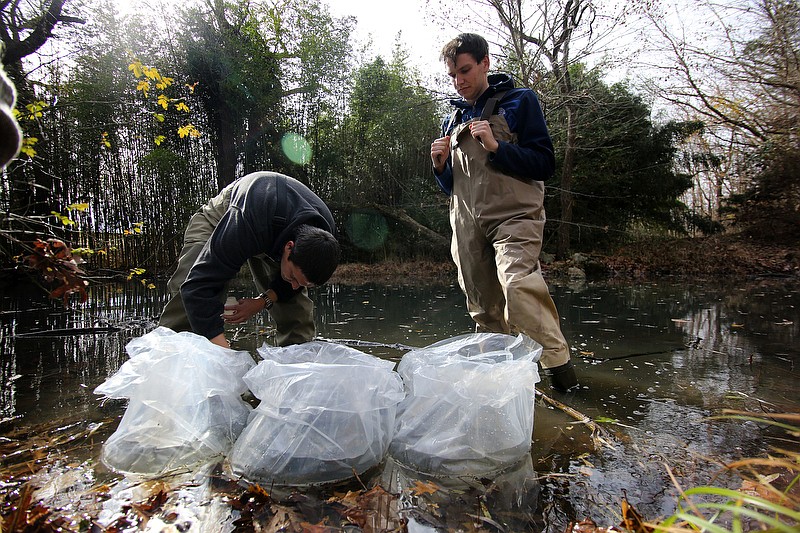One of the last wild populations of Barrens topminnow survives, with help, in a small pond on private property just feet from a Summitville, Tennessee, highway.
The population of colorful fish only found on the Barrens Plateau in Central Tennessee has been decimated over decades, with competition taking it to near extinction. A working group of private and public partners - the Tennessee Aquarium, Conservation Fisheries in Knoxville, Tennessee Wildlife Resources Agency, and U.S. Fish and Wildlife - have monitored the species for decades to ensure its survival. Without their interference, the population would likely be gone, having died off from changes in climate, land use and competition.
The working group unsuccessfully tried for years to introduce the species to new habitats, but those efforts largely proved futile.
There's little hope the species will ever thrive.
However, there is now a belief the fish - which averages about 4 inches in length when fully grown - may be able to be managed in that existing habitat. The fish received federal protection in October, becoming listed as an endangered species. The listing will open funding opportunities for hatcheries to work with the population to ensure its survival.
"We've been funding projects for this species for years, but now it's within our responsibility to keep these fish alive," U.S. Fish and Wildlife Service listing recovering biologist Warren Stiles, who wrote the 2017 status assessment that informed the federal listing, said.
The groups first proposed for federal listing in the 1970s when the species was discovered. The partners worked to create a description and named the species "Barrens topminnow" after the plateau on which it was discovered.
"This is the population that we consider the type locality," Tennessee Aquarium Curator of Fishes Matt Hamilton said. "This site is where the species was described from, so it's got a lot of historical significance."
However, the groups had trouble gaining access to the fish. There was strong pushback from the public at the time since the known populations were on private land.
"The fish and wildlife service just about got ran out and tarred and feathered on a pole," Conservation Fisheries co-director Patrick Rakes said. "They were not welcome."
Eventually, the groups were able to work with landowners to gain access to a few of the populations.
Total population area for the fish is up for debate. At most, the fish is found in about nine areas - all in Coffee, Cannon, DeKalb and Warren counties. However, that may be generous, according to biologists. Most of those populations aren't considered sustainable. Either invasive mosquito fish have moved in and will eventually outcompete the Barrens topminnow or the entire population consists of just a couple of fish.
In reality, there are less than a handful of places the fish can be found. And even the long-term viability at those sites is in question. The small pond off the Summitville highway is likely one of the best examples of a healthy Barrens topminnow population.
The fish are located outside a cave on private property along McMinnville Highway. After the species was described, the groups put up a barrier between the stream and a culvert running under the highway to expand the waterway into a small pond and give the fish a slightly larger habitat.
The approximately two-foot-high concrete barrier has since kept the fish protected. It secludes the species from western mosquito fish that have since moved east, outcompeting many of the Barrens topminnow populations on the plateau.
Now, for the working group, it's about protecting one of the last populations of the Tennessee fish. That small pond is prone to drought. So when a record hot, dry September and October came, the aquarium and Conservation Fisheries each took 200 fish in a range of ages and size (to diversify and strengthen the gene pool in case the wild population died). They kept them in captivity until the pond fully refilled and could safely hold one of the last remaining populations of Barrens topminnow.
For the groups, it's been decades of work and money to protect one tiny population of a small Tennessee fish. Why? Because they believe they should, Rakes said.
"It's a fish that God created, if you want to look at it that way," he said. "What right do we have to let it go extinct?"
Contact Mark Pace at mpace@timesfreepress.com or 423-757-6659. Follow him on Twitter @themarkpace and on Facebook at ChattanoogaOutdoorsTFP.

